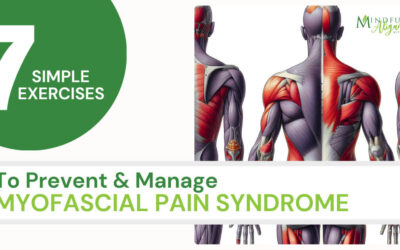Managing Pain Between the Scapulas
We’ve all been there: one minute you’re fine, and the next, a nagging pain between your shoulder blades makes everything seem harder. It can throw you off your game, making simple activities a chore. But don’t worry—understanding this common issue is not just the first step, but a powerful tool that puts you in control of finding relief and preventing it from coming back.
What is Pain Between the Scapulas?
Pain between the scapulas, also known as Interscapular pain, is discomfort or pain felt in the upper back, specifically in the region between the shoulder blades. This area of the back supports a variety of movements and is integral to our daily activities. When we experience interscapular pain, it can significantly impact our quality of life.
Here are some of the possible causes of pain between the scapulas:
- Slouching or Sitting: Slouching or sitting for long periods with improper back support can strain muscles and ligaments.
- Repetitive Movements or Heavy Lifting: Repetitive movements or lifting heavy objects using your back instead of your legs can lead to muscle strain.
- Underlying Medical Conditions: Pain between the scapulas (interscapular pain) can sometimes be indicative of other underlying medical conditions. It’s essential to be aware of these conditions so you can seek appropriate treatment and not overlook any serious issues.
Medical conditions that might be confused with pain between the scapulas include:
- Acid Reflux: Stomach acid backing up into the esophagus can cause pain that radiates to the upper back.
- Heart Conditions: Conditions like a heart attack or pericarditis (sac inflammation around the heart) can cause pain between the shoulder blades.
- Gallbladder Disease: Pain from internal organs like the gallbladder can present as pain between the scapulas.
- Aortic Dissection: A tear in the inner layer of the aorta can cause severe chest pain that radiates to the back.
- Degenerative Disc Disease: Wear and tear on the spinal discs can lead to pain in the upper back.
- Scoliosis: An abnormal curvature of the spine can cause discomfort between the shoulder blades.
- Myofascial Pain Syndrome: Chronic muscle and surrounding tissue pain can cause persistent discomfort.
- Herniated Discs, Osteoarthritis, or Spinal Stenosis: These conditions can result in pain between the shoulder blades.
Some common symptoms of pain between the scapulas include:
- A persistent, dull ache that can be mild or severe.
- Stabbing pain that may occur with movement.
- Stiffness in the shoulders or upper back.
- Pain that spreads to other areas, such as the neck, arms, or lower back.
How to Manage Pain Between the Scapulas
- Rest: If you have interscapular pain, give your body time to heal and avoid activities that trigger pain.
- Strength and Flexibility: Improve the strength and flexibility of your back and core muscles with regular exercise. Stretch daily for improved flexibility.
- Medication: Over-the-counter pain relievers like ibuprofen can reduce inflammation and pain. Applying ice packs or heat pads to the affected area can provide relief.
- Good Posture: You can prevent pain between the shoulder blades by maintaining good posture.
- Proper Lifting Techniques: Use proper lifting techniques when lifting heavy objects. Bend your knees and keep the object close to your body. Use your legs instead of your back muscles.
- Movement Breaks: Avoid sitting or standing in one position for too long. Taking regular breaks to move and stretch will help maintain flexibility.
- Professional Support: Seek professional help from a chiropractor to realign the spine and relieve pressure.
Dealing with interscapular pain can be frustrating. Still, you can manage and prevent it with the proper knowledge and proactive measures. Remember, your body is incredibly resilient, and with some care and attention, you can get back to living your best life, pain-free. If your pain persists or is severe, don’t hesitate to seek professional medical advice. Your health and well-being are worth it.
Stay strong, stay active, and take care of yourself. Your health is your most valuable asset, and by staying active and taking care of yourself, you’re making a powerful commitment to your well-being.
Here’s a few videos to help you on your wellness journey:
Are you tired of living with pain?
Are your activities and daily choices determined by your level of pain?
Are you ready to change your life for the better and gain back your physical freedom?
My unique and custom designed approach comes from years of training, education and experience. Together, we will get you back to living pain free and enjoying life.
Sign up for a private session today
It’s never too late to try something new.

Related Articles:
Transform Back Pain Anxiety: From Uncertainty to Empowerment
Discover how to navigate pain anxiety with empowerment. Embrace uncertainty and reclaim your healing journey through mindfulness and resilience.
Transforming Your Relationship with Back Pain: A Mindset Revolution
Back pain is more than a physical challenge—it's a profound psychological journey. The real battle isn't just in your muscles and joints, but in your mind. Your thoughts can either be a prison or a pathway to healing. Reframing Your Inner Narrative When chronic pain...
Embracing Change: A Journey of Small Steps
Embracing change through small steps: Focusing on small, consistent steps emphasizes sustainability and avoids overwhelming change, which is key to maintaining health goals.
Preventing and Managing Myofascial Pain Through Exercise
Prevent and manage Myofascial Pain Syndrome in the back with these daily movements and targeted exercises. This approach provides an effective solution.




